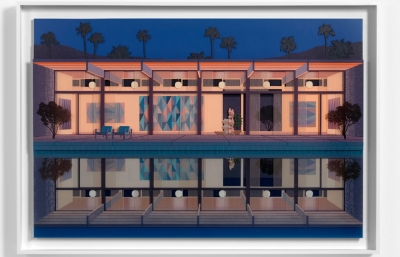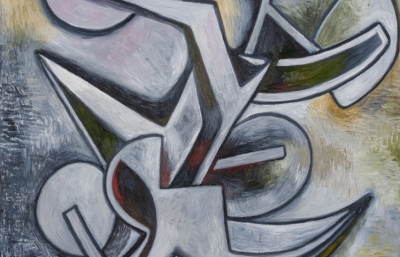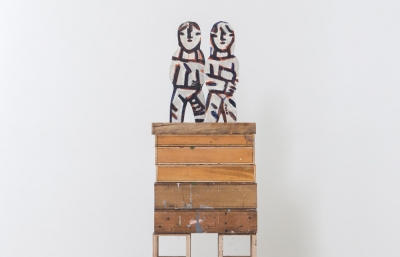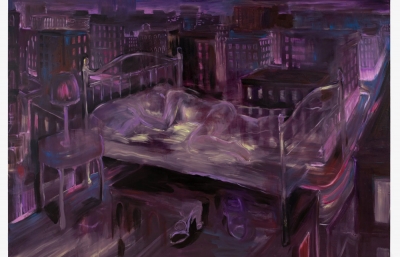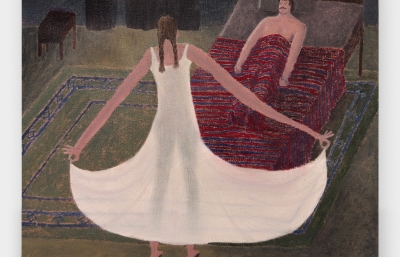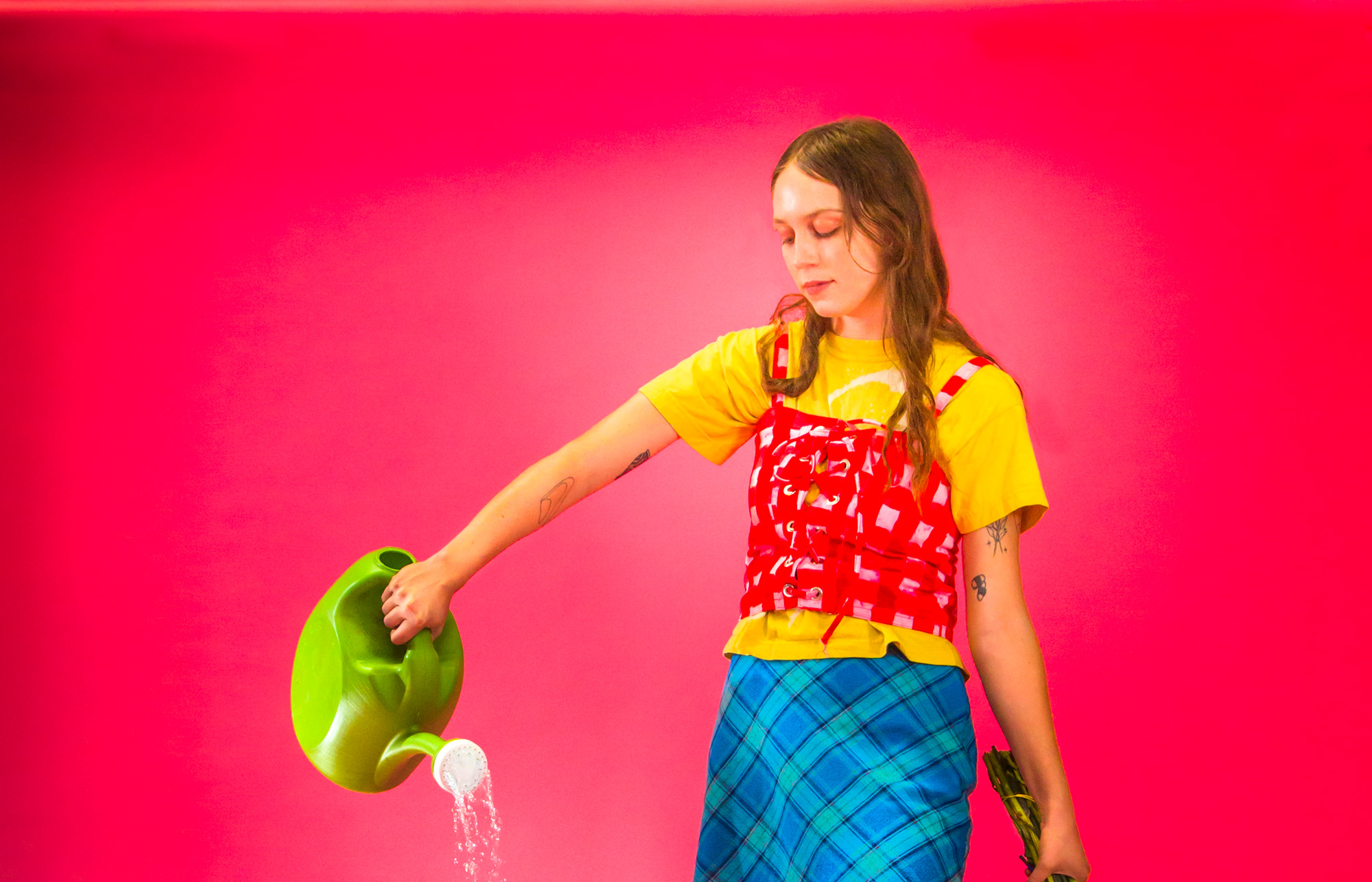
Anja Solonen
The Indolent Gaze
Interview by Kristin Farr // Portrait by David Broach
Figurative painting has long been a compulsion of artists, and only the remarkable make headway in the game. Anja Salonen is deep into the uncanny, concocting color and mood to present an alternate reality, a dimension similar to ours, but not quite right. The aesthetic notion of the uncanny valley describes the uncomfortable reaction humans experience when faced with a clone-like being. The global merger of the real and virtual has forced an increasingly blurred line between the two, and the prevalent, dubious honesty of the contemporary gaze is challenged in Salonen’s work.
Eerie, exceptional, astounding, creepy and mystifying are descriptors akin to uncanny, and could also describe these paintings of a world that oddly reflects the one we know. Salonen’s practice explores what it means to be alive today and the way paint relates to the body. She responds to the slump of our current situation of glaring into screens as the world implodes. Through painting, she emphasizes this era—the evolution of physicality, emotion, and our new defense mechanisms, and she does so with a remarkable vision.
Kristin Farr: Who are the people you are painting and what are they most often experiencing?
Anja Salonen: Most of the figures that I develop begin with a reference to my own body. I photograph my friends posing for me whenever they are willing, but the work is largely based off of photographs that I take of myself enacting the poses that I envision for the paintings. The figures appear to be experiencing boredom, malaise, disturbance… the gaze often meeting the viewer’s, or idly detached, mouth slightly gaping. I want the figures to hold weight and appear despondent.
What makes successful figurative painting in your mind?
I can’t really isolate what makes a successful figurative painting because I’m attracted to such a wide range of stylistic and conceptual choices

I think that paintings that are pushing the boundaries of body constructs and representation, and different ways of talking about the body in space are the most interesting to me right now.
Some forever favorite painters of mine are Pontormo, Manet, Helene Schjerfbeck… More contemporary painters that I really connect with are Tala Madani, Jordan Kasey, Tschabalala Self, Robin Francesca Williams, Ambera Wellman, Sascha Braunig, Cheyenne Julien, Anders Oinonen… the list goes on.

How would you feel if you ended up at dinner with the people you paint?
Probably pretty frightened, but it’s also kind of all I want. I want my figures to be rendered to the point of believability, but for the belief to be in an alternate space and reality or dimension. To me, it sometimes feels more like I’m exposing a world than creating one. I’m really interested in Masahiro Mori’s concept of the “uncanny valley,” in which he hypothesized what humanity’s reaction would be to robots that look almost like people, but not quite—on the border of empathy and revulsion, closeness and othering. He wrote about a relationship between the resemblance of an object to a human and the emotional response that the object elicits. My paintings are objects, flat planes, that hold the illusion of a somatic reality, and that reality’s location on the spectrum of familiarity and alienation also potentially affects the elicited emotional response in the viewer. I think a lot about dimensions, alternate realities, the subjectivity of objects, illusion, delusion. So, yeah, I would kind of like nothing more than for my own body to enter that reality.
What do you like most about exploring the body?
The body as subject matter has always been central to my work for a lot of reasons. It is a point of access, a collective experience, a political ground. I’m interested in the physicality and complexity of the body as an expressive tool, and in using the representation of bodies as an entry point for discussing representation and images in general. I’m also interested in the body as a site and source of trauma, the complex relationship between the interior and the exterior, and the body’s role in forming self-image, the grotesqueness as well as the beauty and vulnerability, and the identity politics that are tied to each specific body.
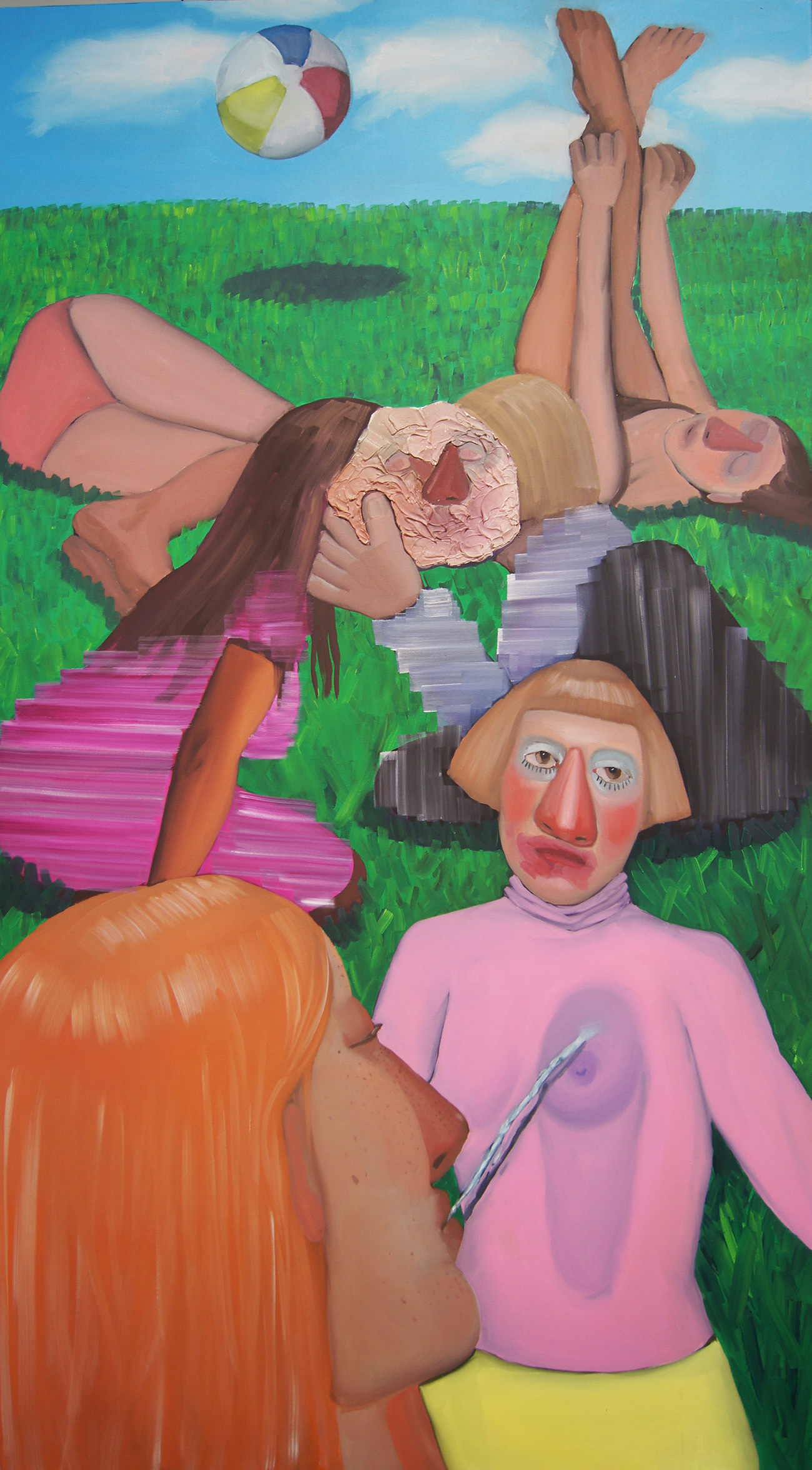
How do you relate the physicality of paint to the body?
Oil paint is a pretty mystical practice to me. Like, absolutely alchemical, using oils and pigments from the earth to create a flat illusion of that same earth… Oil paint, for me, contains this similar uncanny sense of being of the body, but not quite. Its smoothness and viscosity has the power to express some really specific and esoteric behaviors of flesh, light, and color, and I often feel like I’m sculpting much more than drawing while I paint. The paint on the canvas is also a direct record of a motion extended from my body, but the paint seems to have its own momentum. I feel like I’m working with paint’s natural behavior rather than controlling it, and manipulating it to look a certain way, but I’m constantly amazed by paint’s own generative ability. I feel like I’m in a dialogue with my materials as I work. I’m sculpting a world, while the paint and the brushes behave in their own ways as objects, and every new brushstroke I make is a decision based off of an internal process that is as equally based in my concept for the piece as it is in learning from the materials.
You’ve used oil paint since you were a kid. How did your training affect what you’re doing now?
I totally fell in love with oil paint as a material at a young age, and feel like I have a very deep relationship with it. I learned how to paint primarily from life, and studied my own face a lot as a way to practice. I think a part of this relationship to self-portraiture is a means of trying to understand or connect to my physical body, understanding the boundaries of my specific identity. I’ve fluctuated through different painting styles over the years and departed from my classical training for a more gestural, surreal style for a while. Recently, I’ve been kind of merging the two, rendering these more fantastical and colorful scenes in a tighter, three-dimensional way to create the illusion of a complete alternate world.
Are you trying to capture how we feel inside or how we feel we are perceived by others?
I guess both. I’m really interested in depicting how it feels, psychologically and somatically, to be alive right now, and that applies both to the ways we feel about ourselves and about others.
Do your paintings take the lead when it comes to composition? Do you start with a sketch?
I’ll usually start with an idea, gather source material for it, do a rough compositional sketch, and then work on the canvas.
The composition sort of naturally creates itself as I lay out the components of the painting, and the initial idea changes a lot with each step of the process. I often work in larger series of paintings, creating a cohesive body of work that contains its own composition and direction of ideas. I like making specific work for each show I do because I want the paintings to work as one larger piece.
How is living in LA influencing your work right now?
I started working in the color pallette I use now when I moved into my first studio in LA in the fashion district, down the street from Santee Alley. The streets are completely overflowing with neons and plastic and furs and fake plants. The LA light must be interesting to every painter here in some way… The colors, the haze, the natural environment, desert flora, the beach, the strip malls, the weird hidden magic things. LA space is also so deeply strange… so broad and vast, sprawling. Ocean, mountains, big sky…
How do you describe your personal aesthetic and does it match your paintings?
The way I design my surroundings and personal aesthetic is really tied to creating a color composition. I wear and surround myself with color combinations that I like, treat my outfits in a similar way, and even my meals.
What feelings are you most often trying to project into the work and onto your audience?
Despondency, illness, humor, beauty, disgust, attraction, familiarity, alienation, weightlessness, heaviness—a lot of contradictions.
What do you want to add to the dialogue about the body and corporeality?
A new aspect of corporeality that figurative painters are navigating right now is how the three-dimensional body interacts with digital space and flat images. Digital space is a new landscape, with its own illusion of constructs of gravity, layering, light and shadows. This has sort of changed the perspective direction of a lot of post-analog painting, because whereas before, figurative painting functioned as a “window,” a recessive space with the illusion of depth, now there is a push towards illusionistic projection and forward movement. Artists are calling attention to not only the surface of the painting, but the space in front of it, and I think this idea of projection is directly tied to the spatial shift of the virtual.
What are you painting now and what’s coming up next for shows?
My solo show opened in November at ltd Los Angeles. It’s called New Dimensions in Recreation. The body of work I’ve made for this show consists of three-dimensional wooden panel structures painted with illusionistic three-dimensional images.
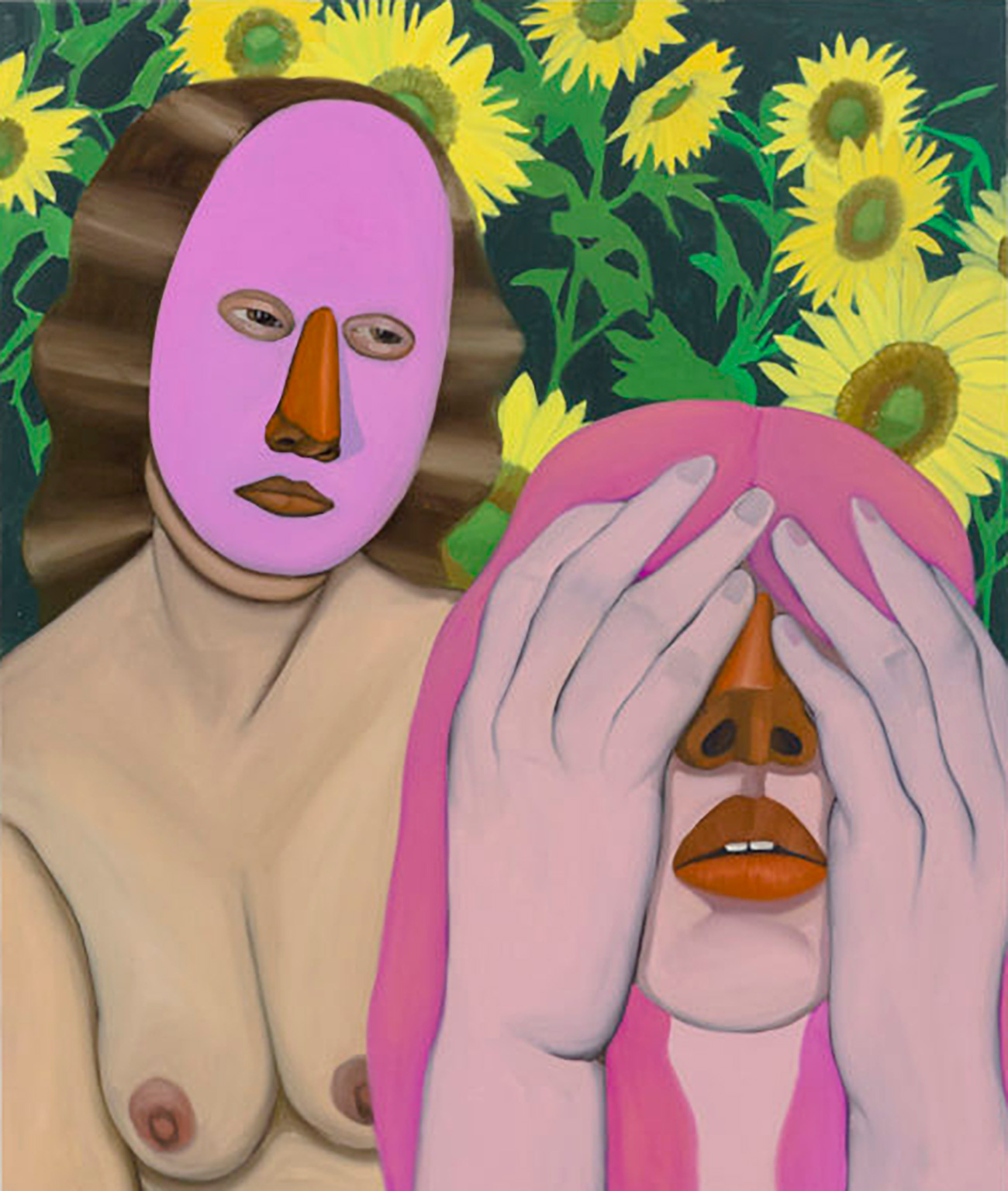
The paintings show malaise in its tangible and mediated forms—an essentially three-dimensional, palpable body processed as a flat image, reaching a final form of dimension in real space. In the work, reality is mutable, shadows cast by fluorescent lights on the three-dimensional objects melting into painted illusions. There is no truth, the flat and the illusory and the dimensional, projections and contractions, fluidly moving in and out of one another and through space without hierarchy. The limitations of self-image during the apocalypse—at what point of distortion the self becomes something else—and what tells you something is wrong.
What are you doing tonight?
I’m going out to the desert to see my dear friend’s noise performance and stay in a house in Fontana, and go to Andrea Zittel’s High Desert Test Site in Joshua Tree.

Who have been your best non-traditional teachers in life and art and what has been their most memorable advice?
My fourth-grade creative writing teacher who taught me about existentialism, a painter I took lessons from when I lived in London in high school who taught me about loving, sensitive portraiture. My first piano teacher, my sculpture professor at RISD who believed in magic, many of my dearest friends. My mom. It’s hard to pinpoint exact statements of advice, but I think the common thread of my most meaningful learning experiences have been in finding an honest connection with someone who sees something about the world that I do.
Anja Salonen’s solo show at ltd Los Angeles is on view through December, 2017.
anjasalonen.com

